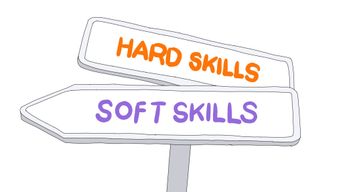Emotional Intelligence: Corporate Buzzword or Essential Skill?

The phrase “emotional intelligence” (EI) has been enjoying a rapid rise in popularity. In just the last couple of years, publications from Forbes to Harvard Business Review have covered the topic in depth. Maybe you’ve seen EI discussed in the business and L&D literature so much lately that you’re wondering if it’s just another corporate buzzword or a major emerging trend like AI and Digital Transformation. Not to spoil the suspense, but as the data below will demonstrate, it’s definitely the latter.
In this post, we’ll explore why emotional intelligence is an invaluable skill set in any workplace. We’ll also review the core skills that make up emotional intelligence and discuss the enormous benefits of helping your staff acquire them.
In Business Success, EI Plays a Bigger Role Than Brainpower
If you’re wondering why emotional intelligence has become such a popular concept in the business world lately, one obvious reason is that a growing body of research shows EI creates bottom-line benefits for organizations—from corporations to nonprofits to government agencies.
Consider this research from Texas Tech University professors Jared Allen and Regan Stevenson that was published in the Strategic Entrepreneurship Journal:
In this meta-analysis, which covered data on more than 65,000 business owners, the researchers found that emotional intelligence is a far better predictor of business success than raw brainpower. This held true even when the researchers measured success using different criteria, such as switching from revenue to company growth.
If a skillset can account for 90% of the difference between business failure and business success, then it’s more than just a buzzword. Emotional intelligence is an essential skill for any manager.
Emotional Intelligence: An Essential Skill
One reason some professionals have been slow to embrace emotional intelligence as an essential workplace skill set is its unfortunate labeling as a “soft skill.” That term underplays the tremendous value EI can bring to an organization—by helping employees and managers make better decisions, build stronger teams, and better serve customers.
In fact, as corporate advisor and former Deloitte partner Josh Bersin has argued, we’d be more accurate viewing emotional intelligence as the hard skills of today and tomorrow:
Hard Skills are soft (they change all the time, are constantly being obsoleted, and are relatively easy to learn), and Soft Skills are hard (they are difficult to build, critical, and take extreme effort to obtain).
Let’s try a thought experiment. Imagine your organization had to replace its top three executives. Knowing what you’ve just learned about EI as a predictor of business success, would you rather bring in three genius-level execs with average emotional intelligence, or three bright (though not brilliant) leaders who were also extremely emotionally intelligent?
Are Your Managers (and Employees) Emotionally Intelligent?
Perhaps you’re thinking that your employees already have high levels of emotional intelligence. But do they? Self-assessment is a notoriously poor way to measure subjective skills. Truth is, while we all know people who are charismatic or empathetic, that’s a far cry from having the conscious, repeatable skills of emotional intelligence.
So let’s review some of the key skills that comprise emotional intelligence. As you read through these details, ask yourself if the people in your organization would benefit from being trained in these skills.
Emotion recognition
This skill involves identifying your own emotions by observing our feelings, conscious thoughts, physical sensations, and physiology. Emotion recognition is an essential first step in using our emotions to achieve our goals since we can only succeed in this effort if we can identify where we’re starting the process emotionally.
Emotion recognition has numerous challenges:
- Too often, we’ve simplified our emotional model to glad-mad-sad, thus eliminating the possibility of identifying our actual emotional state. There are hundreds of distinct emotions!
- In a business setting that discourages the expression of emotion, we often train ourselves to ignore our emotions.
- It takes attention to observe our emotions as they shift throughout the day. It’s not a “one and done” process.
Emotion regulation
Once you’ve recognized your current emotion and identified the emotion that would best support your current goals - whether it’s giving a rousing presentation, listening carefully to an important customer, or supporting a colleague in distress - the next step is to regulate your emotions to achieve the desired emotion.
Regulation is a key part of EI and it’s not always easy in real-life situations.
- There’s a long list of regulation techniques to draw on and it’s up to you to pick one in the moment that matches your goals.
- Regulation strategies often come down to a matter of personal preferences. For example, a mindfulness technique can work for one person and seem unbearable to someone else.
- You’ll need a degree of fluency to regulate in real life. When things get intense, you rarely have the luxury to open a book or an app to refresh your memory.
Emotional co-regulation
This skill involves recognizing the emotions of another person and using our skills to achieve a compatible set of emotions, for them and for us. For example, if a colleague is stressed out before you jointly make a big sales presentation, you can use co-regulation techniques to help them achieve a measure of calm before you start.
The challenges with this skill:
- We grossly overestimate our ability to read other people’s emotions. What we’re often doing, instead, is projecting our moods (or wishes) onto others.
- Our cultural backgrounds and other biases can cloud our ability to accurately identify the emotional signals others are projecting.
- We may not be well-regulated ourselves; we can only co-regulate productively when we have effectively recognized and regulated our own emotions.
- There is a fine line between emotional co-regulation (positive) and trying to control another person (negative). Knowing how to avoid crossing that line requires emotional intelligence training.
Now, when we combine all the points we’ve discussed—emotional intelligence is one of the best predictors of business success, it’s an essential skill for business, and the chances are your staff could improve their EI levels—you can see the strong bottom-line case for rolling out emotional intelligence training across your organization. Are you ready to take the next step?
Latest Posts
BACK TO HOME ❯ Developing New Managers? How to Set Them Up for Success
Developing New Managers? How to Set Them Up for Success
 First-time Managers Are Holding Back Employees & Performance
First-time Managers Are Holding Back Employees & Performance
 Why New Managers Fail and How Oji Foundations is Revitalizing Leadership Training
Why New Managers Fail and How Oji Foundations is Revitalizing Leadership Training
Sign up for our People-Powered Newsletter.
